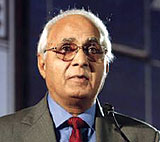Land Acquisition Act 1894 was an imperial legislation enacted to acquire land for public purpose for development of the Empire. At a time when a new Act is on the anvil, it is necessary to examine the development of Gurgaon as a city which was a major challenge for DLF Chairman, Dr. K P Singh to acquire 3500 acres of raw land on which a large part of Gurgaon stands today.
The first prerequisite for acquisition was conformity with the Master Plan and the raising of huge amounts of money at a time when bank loans were not available for acquisition. Even after land was purchased there was no guarantee that license will be procured. Bureaucratic delays due to change in land use, environmental approval and clearances under Right of Pre- emption Act Agricultural Ceiling Act were formidable. |

K. P. Singh |
Some of the important lessons learnt by K P Singh are recounted for the purpose of a suitable Land Bill. Major problem in private land acquisition is the fear of farmer that he is not getting proper compensation. DLF adopted a humane and pragmatic approach in assembline large tracts of land.
K P writes in his famous biography 'Whatever the Odds’, “It gives me an immense sense of satisfaction that DLF was able to acquire thousands of acres of land without a single case of litigation or even a hint of violence or protest.”
As average land holding was 4-5 acres and acquisition entailed interaction with 500-700 families at a time, K P followed a strict regimen and made sure that farmers selling land to DLF became partners in prosperity. As land in Gurgaon was unproductive but DLF needed it for developing a modern city, K P would explain that he would help them buy ten times more land and better agricultural land if they sold to him. Another problem was the Hindu Undivided Family Law which gave women equal right to ancestral property. Hence they were required to sign the sale deed for title to be valid. K P adopted humane approach in case some patriarchal families did not want women to be paid on the plea that they received their share at the time of marriage. In some case he would pay secretly and in some cases look after their health, education, financial and other needs meticulously as a matter of humanity in a selfless manner.
Partnership in Prosperity had another dimension. After handing them over the money, DLF asked whether they needed so much money. Frankly they had not seen so much money and did not know what to do with it. So they were invited to invest the same in DLF to become equal partners in prosperity at an interest of 12%-a princely sum. K P writes, “1980s it was an attractive proposition they could withdraw the principal amount whenever needed and have interest flowing. A jeep would go from house to house distributing interest. They would need money for marriages and got it.
Their children sought employment and got it and DLF would not grown into what it became without partnership with these uncomplicated and honest farmers- says K P. At that time the selling price per acre was Rs. 50.000 and today it is Rs 40 million acre. Ordinary farmers helped DLF grow and the Company helps them to grow through DLF Foundation by providing education and jobs. This was history in making and LARR Bill under enactment needs to honor men and women who made ethics their business.
|